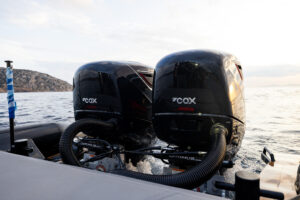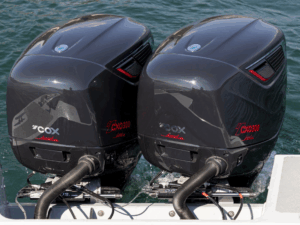Diesel Outboard Engines: Advantages, Operation, and Comparisons with Other Propulsion Solutions
The demand for greater fuel savings, lower CO2 emissions, and higher performance is driving interest in diesel outboard engines. For those working in the commercial maritime sector, public services, or for leisure boat owners, diesel outboards offer several advantages over gasoline-powered alternatives, including higher efficiency and torque that allows for powerful thrust and acceleration. Switching to diesel also supports single-fuel strategies for larger fleets already running on diesel elsewhere.
In this article, we’ll cover everything you need to know about diesel outboard engines, including how they work, their benefits, limitations, key trends, and engine types.
What is a Diesel Outboard Engine?
A diesel outboard engine is a self-contained external combustion engine that integrates the powerhead, gearbox, and propeller, mounted on the stern (transom) of the vessel. While gasoline outboards are common in leisure boating, diesel outboards are typically used for heavier-duty, long-range, and commercial applications. Their high efficiency, durability, and fuel safety make them an attractive alternative.
Diesel has a higher energy density than gasoline, which is the key to superior fuel economy and a significant advantage over long distances, when fuel optimization is a priority. Diesel engines also deliver greater torque, making them ideal for towing loads, handling heavy vessels, and working in challenging marine conditions. Additionally, diesel is less flammable than gasoline, reducing the risk of fire in marine environments.
How Diesel Outboard Engines Work
One of the main advantages of a diesel outboard is greater fuel efficiency. This comes from “lean-burn” technology, which uses less fuel and more air to achieve the same performance as gasoline engines—typically delivering 30–35% better fuel economy. Lower fuel consumption also translates to reduced emissions, meeting stringent environmental regulations.
A diesel engine operates on the principle of compression ignition. Air is drawn into the combustion chamber and compressed at high pressure. Fuel is then injected directly into the chamber, where the compressed air is hot enough to ignite the fuel automatically, creating an explosion that pushes the piston downward and generates mechanical power. Exhaust gases are expelled, and the process repeats.

Back to Basics – The Different Types of Outboard Engines
Commercial outboard motors are available in various types, depending on fuel, power source, and intended application. These engines are widely used across transport and maritime operations. Below is an overview of the main types:
Gasoline:
- Two-stroke engines: Simple design that mixes fuel and oil. Lightweight and high power-to-weight ratio. While powerful, efficient, and cheaper than diesel, they have higher fuel consumption and emissions, often failing to meet modern environmental standards.
- Four-stroke engines: Separate oil and fuel systems, providing cleaner, more efficient combustion. Heavier and generally more expensive than two-strokes. The largest gasoline outboard reaches 600 HP.
Diesel:
Designed for heavy-duty use, diesel outboards provide more torque at lower RPMs. Diesel is more fuel-efficient and cost-effective in long-term operation, more durable, and better suited for heavy loads.
The trade-offs include higher upfront costs, greater weight, more noise, and potentially more complex maintenance compared to gasoline. However, they are ideal for long-range travel and commercial operations requiring reliable performance.
Electric:
Powered by onboard batteries or hybrid systems, some electric outboards are completely emission-free—especially beneficial in areas with strict environmental regulations. They offer quiet operation, minimal maintenance, and growing range thanks to battery advancements. Currently, range and battery life remain limited, making them more suitable for tenders and small craft. The most powerful electric outboard today is 300 HP, with larger models emerging.
Liquefied Petroleum Gas (LPG/Propane):
An emerging alternative to gasoline. Propane burns cleaner than gasoline or diesel, reducing emissions. It’s more efficient, less costly to operate, and has a long shelf life. However, availability is limited in some regions, and range can be lower than gasoline or diesel.
Hybrids:
Combine a traditional internal combustion engine (gasoline or diesel) with an electric motor, offering flexibility between power sources. This provides zero-emission operation when needed, plus long-range capability with fuel. Still developing in marine applications due to higher upfront costs.
Jet Propulsion Outboards:
Powered by gasoline or diesel, these use a water jet instead of a propeller. Safer in shallow waters and near swimmers, offering excellent maneuverability. However, they’re less efficient than propeller-driven outboards and more prone to clogging with debris, leading to higher maintenance costs.

Diesel Outboards vs. Gasoline Outboards
- Fuel Efficiency
Diesel has a higher energy density, making diesel outboards more fuel-efficient—especially at low speeds and over long distances. Gasoline outboards are less efficient, particularly under heavy loads, though they may be more efficient at higher speeds on smaller, lighter boats.
- Performance
Diesel engines provide strong torque at low RPMs, making them reliable for moving heavy boats or towing loads. However, they usually have lower top speeds and slower acceleration compared to gasoline engines. Gasoline outboards generally offer faster acceleration and higher top speeds, ideal for small, agile boats.
- Durability & Longevity
Diesel engines are built to withstand high stress and long operating hours, often outlasting gasoline engines—making them standard in commercial use. Gasoline engines, while durable, typically have a shorter lifespan under heavy use.
- Safety
Diesel is less flammable than gasoline, reducing fire risk—a key advantage in commercial, military, or offshore operations. Gasoline is more volatile, though modern safety systems mitigate risks. Large-scale storage of gasoline also raises ATEX compliance concerns in Europe.
- Single-Fuel Strategy
Many operators benefit from using diesel across fleets, simplifying storage, logistics, and supplier management.
- Costs
Diesel outboards are more expensive upfront due to their robust construction, but lower fuel consumption and longer lifespan offset the initial cost. Gasoline outboards are cheaper initially but incur higher long-term running costs.
- Environmental Impact
Diesel produces more particulate matter (PM) and NOx, but newer engines have reduced emissions. Because they burn less fuel overall, their carbon footprint can be lower. Modern four-stroke gasoline engines are relatively clean, though two-stroke models remain more polluting.
- Maintenance
Diesel engines need less frequent servicing but can be costlier to repair when issues arise. Gasoline engines are simpler and cheaper to maintain, with more readily available parts, though they may require more frequent upkeep.

Diesel vs. Electric Outboards
Power & Performance
Diesel: better suited for heavy-duty, long-range, commercial use, with high torque and endurance.
Electric: quiet, instant torque, better for small boats and short-range trips. Advances in batteries are expanding their capabilities, but diesel still dominates for long-distance operations.
Efficiency & Fuel
Diesel is fuel-efficient and ideal for long trips, but still reliant on fossil fuels. Electric is highly energy-efficient and has no fuel costs (other than charging), especially when paired with renewable energy sources.
Maintenance
Diesel: requires oil changes, filter replacements, and fuel system servicing.
Electric: simpler, fewer moving parts, very low maintenance, though battery replacement can be costly.
Environmental Impact
Diesel emits CO2, NOx, and particulates, while electric outboards are zero-emission at the point of use. With renewable charging, electric can achieve near-zero carbon footprint.
Choosing the Best Diesel Outboard for Your Boat in 2025
When selecting a diesel outboard, consider:
- Horsepower & torque: match engine size to vessel weight and workload.
- Fuel consumption & range: ensure efficiency for long-distance operations.
- Maintenance needs: choose a brand with strong service and parts support.
- Environmental compliance: verify adherence to IMO and EPA standards.
- Weight & compatibility: confirm your transom and hull design can handle added weight.
Trends Driving Innovation
With stricter environmental regulations, manufacturers are prioritizing reductions in NOx and particulate emissions to meet IMO Tier III and EPA standards. Electric and hybrid propulsion are emerging as alternatives, reducing underwater radiated noise (URN) and vibrations.
Manufacturers are focusing on developing sustainable, clean-combustion diesel outboards that meet evolving environmental standards while improving efficiency. For example, Cox Marine’s purpose-built high-performance V8 bi-turbo diesel delivers at least 30% better fuel economy, lower noise, and reduced emissions—while maintaining peak torque, making it ideal for commercial and leisure use. Hybrid diesel-electric outboards are also emerging as eco-friendly solutions, particularly valuable in coastal and protected marine areas.
The Future of Diesel Outboards
Diesel outboards remain an excellent choice for maritime businesses and public agencies prioritizing fuel efficiency, safety, and vessel durability. Despite higher upfront costs, their torque, fuel savings, and long lifespan justify the investment, especially for commercial operators seeking a single-fuel strategy.
Whether upgrading or installing new, diesel outboards provide reliable power across a wide range of marine applications. With ongoing technological advancements, the industry can expect even more efficient and environmentally friendly diesel outboards in the future.
The Cox Marine V8: 300 HP and 350 HP Diesel Outboards
Cox diesel outboards are the most effective alternative to gasoline outboards, offering several key advantages: up to 30% better fuel efficiency, significantly lower operating costs, support for single-fuel strategies, and improved onboard safety. Built to withstand the toughest marine conditions, Cox Marine engines comply with the strictest environmental standards and deliver reliable, long-lasting performance—from sportfishing to global commercial operations.


